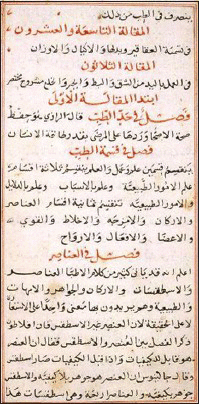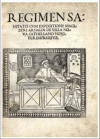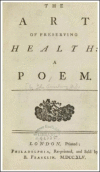The role of Ibn Sina (Avicenna)'s medical poem in the transmission of medical knowledge to medieval Europe
- PMID: 24669114
- PMCID: PMC3963335
- DOI: 10.4103/0974-7796.127010
The role of Ibn Sina (Avicenna)'s medical poem in the transmission of medical knowledge to medieval Europe
Abstract
The Medical Poem ("Al-Urjuzah Fi Al-Tibb") of Ibn Sina (Avicenna, 980-1037), is the subject of this primary-source study evaluating its scientific value, poetics and pedagogical significance as well as assessing its role in the transmission of medical knowledge to Medieval Europe. In addition to one original manuscript and two modern editions, the English translation by Krueger was also studied. Ibn Sina's poem on medicine consisting of meticulously classified 1326 verses, can be considered as a poetic summary of his encyclopedic textbook: The Canon of Medicine; hence its popularity in the East then the West as a tool in the process of transmitting medical knowledge from master to student. Since first translated by Gerard of Cremona (1114-1187) in the middle of the 12(th) century, the Latinized poem was frequently published in Medieval Europe either independently or combined with the Latinized Canon of Medicine or with the Articella; the famous collection of Greco-Roman and Latinized Arabian medical treatises in use in the universities of Salerno, Montpelier, Bologna and Paris up to the 17(th) century. The study of the Krueger's English edition revealed few places where the full meanings of the original Arabic text were not conveyed. A list of those places is given together with the suggested corrections.
Keywords: Arabic medical poetry; Latin translations of Islamic medicine; history of medical education; history of medieval Islamic medicine; medieval medical poetry.
Conflict of interest statement
Figures















References
-
- Ibn Sina al-Husain Abddullah ibn Ali, Urjuza Fi Al-Tibb. Manuscript No. 840/95671/Tibb. Al Azhar Al-Sharif's Manuscript Online Collection. [Last accessed: 23.12.2013]. Available from: http://www.ahlalhdeeth.com/vb/showthread.php?t=70050 .
-
- Ibn Sina al-Husain Abddullah ibn Ali. Al-Urjuzah Al Sinaeyyah Fi Al Masail Al Tibbeyyah. In: Abdel-Majeed, editor. Oorgoozeh or a Treatise on Medicine Originally Written by Abu Ali Ibn Sina. Lucknow: 1829.
-
- Ibn Sina al-Husain Abddullah ibn Ali. Al Urjuzah Al Sinaeyyah. In: Khan MM, editor. Lucknow: Al Matba’ Al Hajari’ (The Hajari Press); 1845.
-
- Paris: Société d’Edition “Les Belles Lettres”; 1956. Avicenne, Poème de la Médecine (The Medical Poem), Al-Husayn Ibn Abdullah Ibn Sina, Urguza Fi T-Tibb (Cantica Avicennae). Texte Arabe, Traduction Française, Traduction Latine du XIIIe siècle, avec Introductions, notes, et index. Etabli et présenté par (edited and translated by) Henri Jahier et Abdul_Kader Noureddine.
-
- Krueger HC. Springfield, Illinois: Charles C Thomas Publishers; 1963. Avicenna's Poem on Medicine.
Publication types
LinkOut - more resources
Full Text Sources
Other Literature Sources

